Analyzing the Efficiency of Monopolistically Competitive Markets
VerifiedAdded on 2023/04/19
|6
|914
|336
Discussion Board Post
AI Summary
This discussion post analyzes the efficiency of monopolistically competitive markets. It argues that these markets are not efficient due to the failure to produce at the minimum of the average cost curve and the failure to produce where price equals marginal cost. The paper explains productive and allocative efficiency, and highlights how monopolistic competitive firms set prices higher than marginal costs leading to reduced consumer surplus and deadweight loss. The post also discusses the impact of entry and exit of firms on market dynamics and concludes that monopolistically competitive industries are not efficient compared to perfectly competitive markets. The paper emphasizes the price-making behavior of firms and their impact on output and pricing decisions, and it explores why these markets are not efficient in both the short and long run.
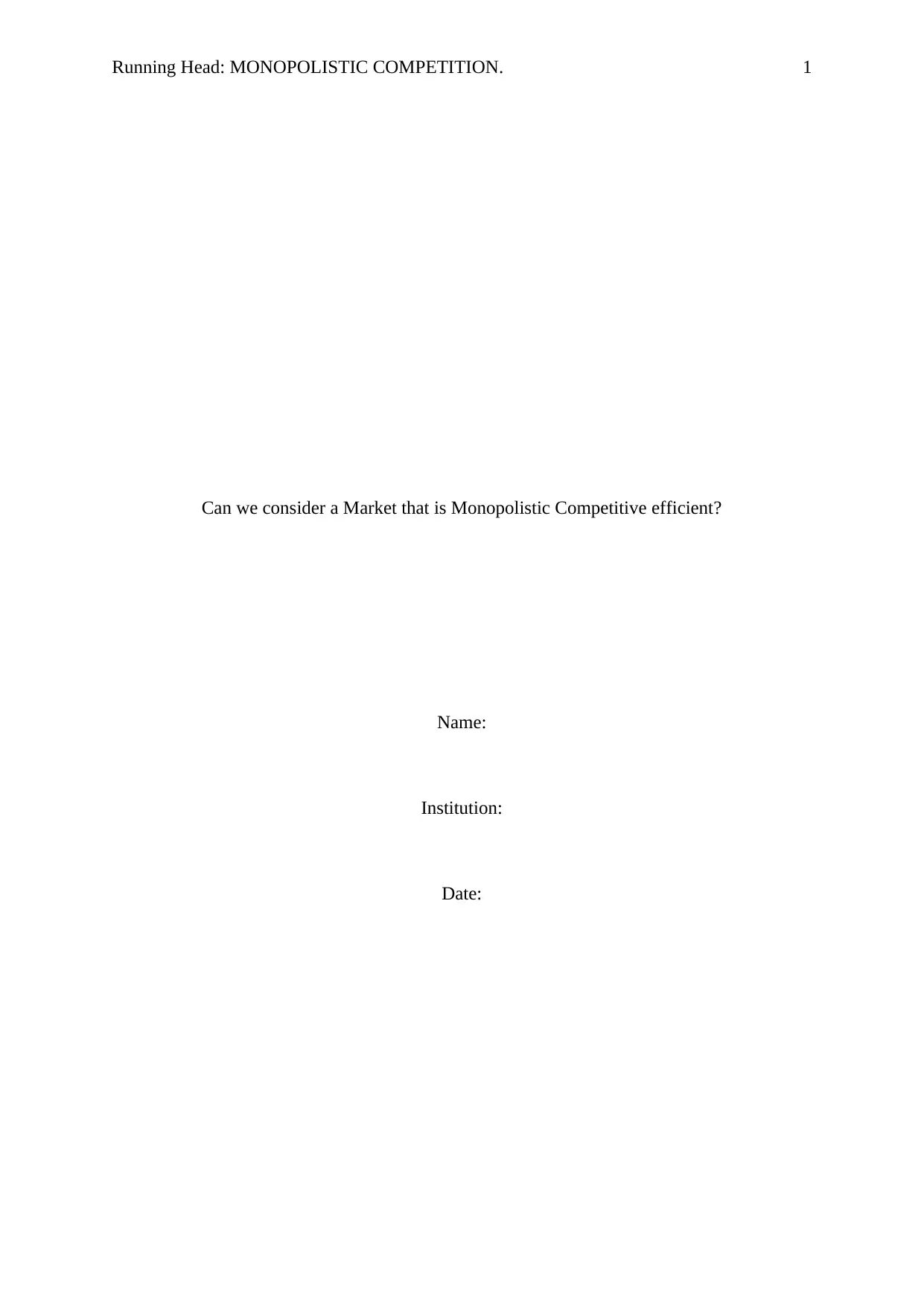
Running Head: MONOPOLISTIC COMPETITION. 1
Can we consider a Market that is Monopolistic Competitive efficient?
Name:
Institution:
Date:
Can we consider a Market that is Monopolistic Competitive efficient?
Name:
Institution:
Date:
Paraphrase This Document
Need a fresh take? Get an instant paraphrase of this document with our AI Paraphraser
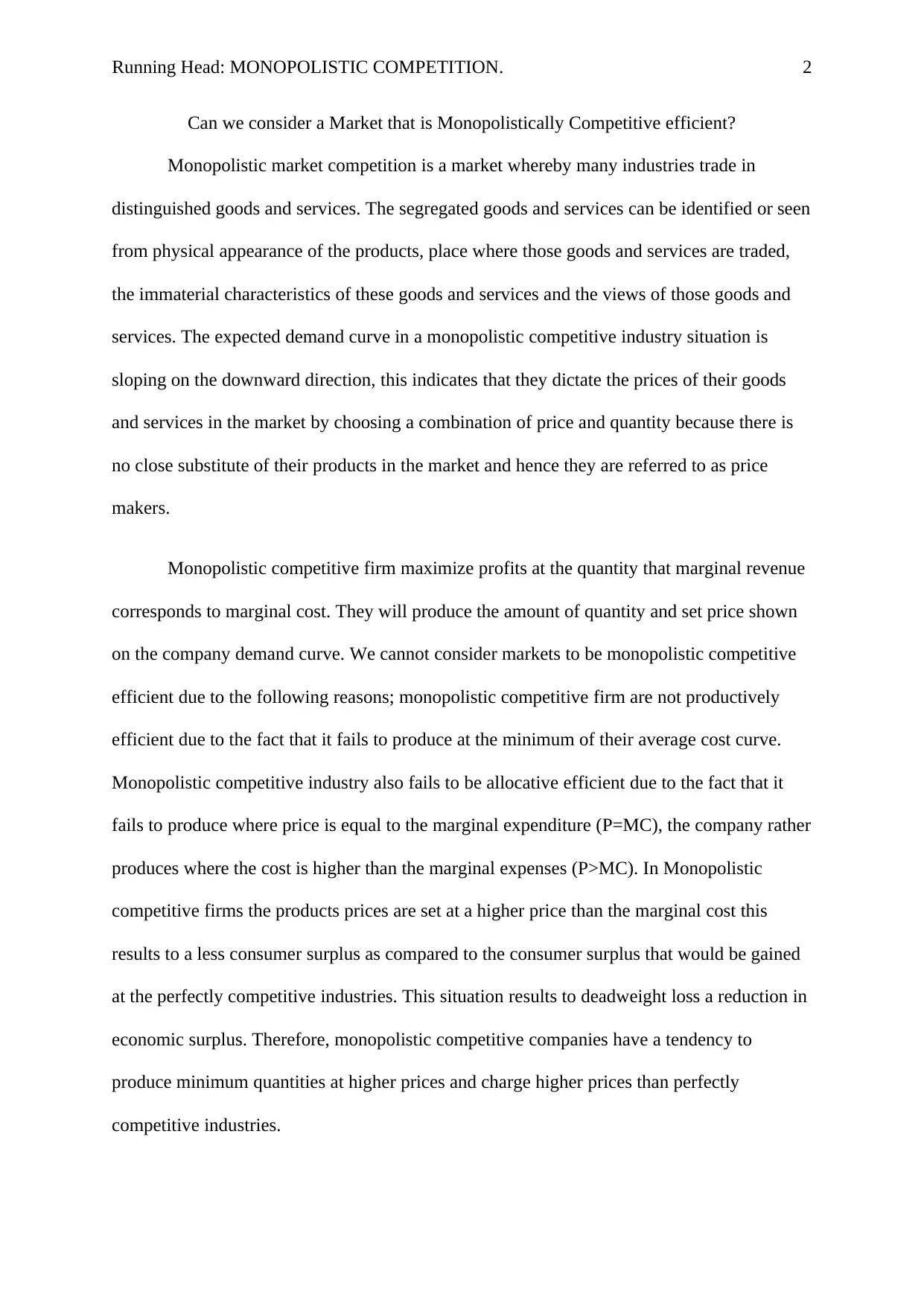
Running Head: MONOPOLISTIC COMPETITION. 2
Can we consider a Market that is Monopolistically Competitive efficient?
Monopolistic market competition is a market whereby many industries trade in
distinguished goods and services. The segregated goods and services can be identified or seen
from physical appearance of the products, place where those goods and services are traded,
the immaterial characteristics of these goods and services and the views of those goods and
services. The expected demand curve in a monopolistic competitive industry situation is
sloping on the downward direction, this indicates that they dictate the prices of their goods
and services in the market by choosing a combination of price and quantity because there is
no close substitute of their products in the market and hence they are referred to as price
makers.
Monopolistic competitive firm maximize profits at the quantity that marginal revenue
corresponds to marginal cost. They will produce the amount of quantity and set price shown
on the company demand curve. We cannot consider markets to be monopolistic competitive
efficient due to the following reasons; monopolistic competitive firm are not productively
efficient due to the fact that it fails to produce at the minimum of their average cost curve.
Monopolistic competitive industry also fails to be allocative efficient due to the fact that it
fails to produce where price is equal to the marginal expenditure (P=MC), the company rather
produces where the cost is higher than the marginal expenses (P>MC). In Monopolistic
competitive firms the products prices are set at a higher price than the marginal cost this
results to a less consumer surplus as compared to the consumer surplus that would be gained
at the perfectly competitive industries. This situation results to deadweight loss a reduction in
economic surplus. Therefore, monopolistic competitive companies have a tendency to
produce minimum quantities at higher prices and charge higher prices than perfectly
competitive industries.
Can we consider a Market that is Monopolistically Competitive efficient?
Monopolistic market competition is a market whereby many industries trade in
distinguished goods and services. The segregated goods and services can be identified or seen
from physical appearance of the products, place where those goods and services are traded,
the immaterial characteristics of these goods and services and the views of those goods and
services. The expected demand curve in a monopolistic competitive industry situation is
sloping on the downward direction, this indicates that they dictate the prices of their goods
and services in the market by choosing a combination of price and quantity because there is
no close substitute of their products in the market and hence they are referred to as price
makers.
Monopolistic competitive firm maximize profits at the quantity that marginal revenue
corresponds to marginal cost. They will produce the amount of quantity and set price shown
on the company demand curve. We cannot consider markets to be monopolistic competitive
efficient due to the following reasons; monopolistic competitive firm are not productively
efficient due to the fact that it fails to produce at the minimum of their average cost curve.
Monopolistic competitive industry also fails to be allocative efficient due to the fact that it
fails to produce where price is equal to the marginal expenditure (P=MC), the company rather
produces where the cost is higher than the marginal expenses (P>MC). In Monopolistic
competitive firms the products prices are set at a higher price than the marginal cost this
results to a less consumer surplus as compared to the consumer surplus that would be gained
at the perfectly competitive industries. This situation results to deadweight loss a reduction in
economic surplus. Therefore, monopolistic competitive companies have a tendency to
produce minimum quantities at higher prices and charge higher prices than perfectly
competitive industries.
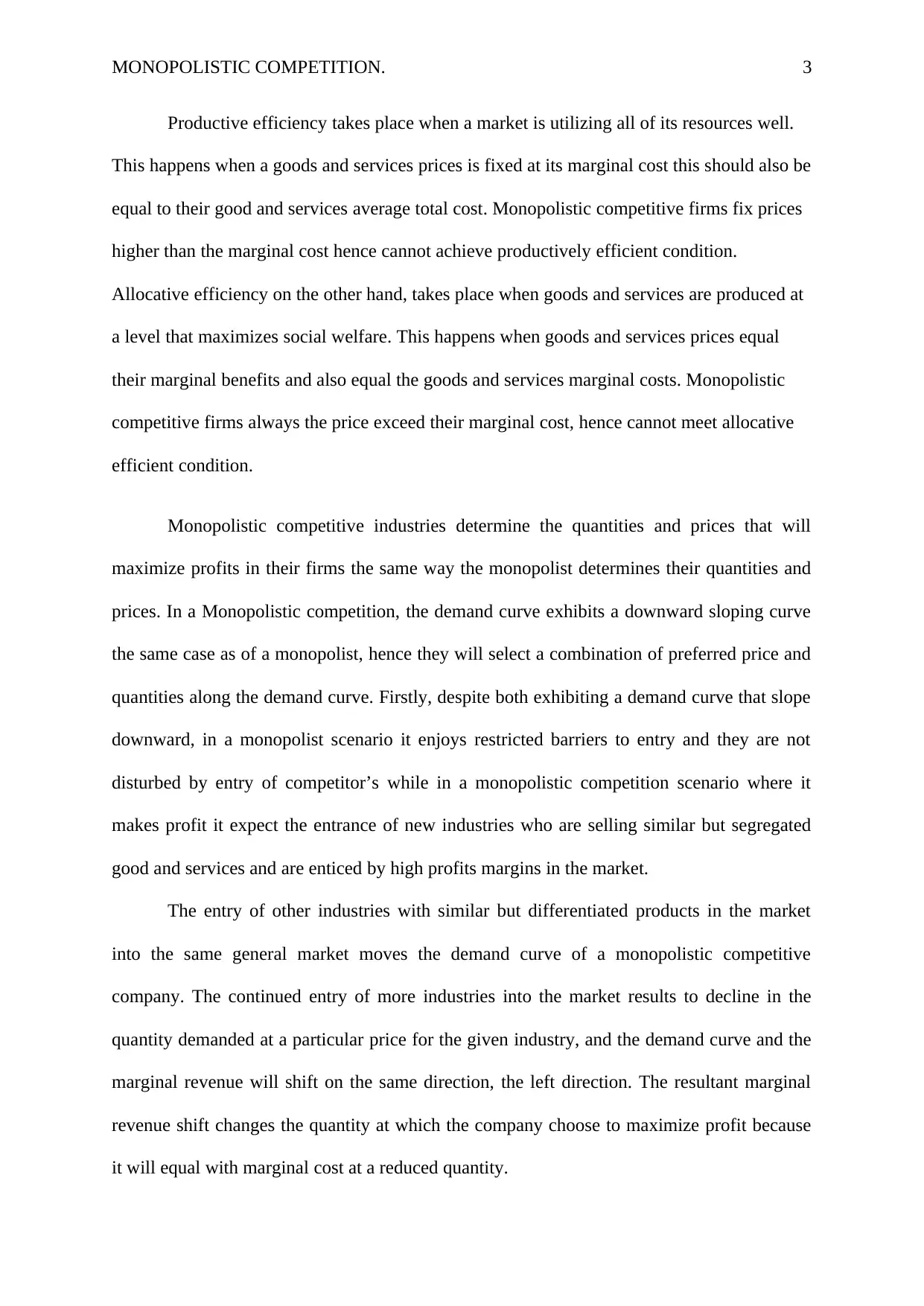
MONOPOLISTIC COMPETITION. 3
Productive efficiency takes place when a market is utilizing all of its resources well.
This happens when a goods and services prices is fixed at its marginal cost this should also be
equal to their good and services average total cost. Monopolistic competitive firms fix prices
higher than the marginal cost hence cannot achieve productively efficient condition.
Allocative efficiency on the other hand, takes place when goods and services are produced at
a level that maximizes social welfare. This happens when goods and services prices equal
their marginal benefits and also equal the goods and services marginal costs. Monopolistic
competitive firms always the price exceed their marginal cost, hence cannot meet allocative
efficient condition.
Monopolistic competitive industries determine the quantities and prices that will
maximize profits in their firms the same way the monopolist determines their quantities and
prices. In a Monopolistic competition, the demand curve exhibits a downward sloping curve
the same case as of a monopolist, hence they will select a combination of preferred price and
quantities along the demand curve. Firstly, despite both exhibiting a demand curve that slope
downward, in a monopolist scenario it enjoys restricted barriers to entry and they are not
disturbed by entry of competitor’s while in a monopolistic competition scenario where it
makes profit it expect the entrance of new industries who are selling similar but segregated
good and services and are enticed by high profits margins in the market.
The entry of other industries with similar but differentiated products in the market
into the same general market moves the demand curve of a monopolistic competitive
company. The continued entry of more industries into the market results to decline in the
quantity demanded at a particular price for the given industry, and the demand curve and the
marginal revenue will shift on the same direction, the left direction. The resultant marginal
revenue shift changes the quantity at which the company choose to maximize profit because
it will equal with marginal cost at a reduced quantity.
Productive efficiency takes place when a market is utilizing all of its resources well.
This happens when a goods and services prices is fixed at its marginal cost this should also be
equal to their good and services average total cost. Monopolistic competitive firms fix prices
higher than the marginal cost hence cannot achieve productively efficient condition.
Allocative efficiency on the other hand, takes place when goods and services are produced at
a level that maximizes social welfare. This happens when goods and services prices equal
their marginal benefits and also equal the goods and services marginal costs. Monopolistic
competitive firms always the price exceed their marginal cost, hence cannot meet allocative
efficient condition.
Monopolistic competitive industries determine the quantities and prices that will
maximize profits in their firms the same way the monopolist determines their quantities and
prices. In a Monopolistic competition, the demand curve exhibits a downward sloping curve
the same case as of a monopolist, hence they will select a combination of preferred price and
quantities along the demand curve. Firstly, despite both exhibiting a demand curve that slope
downward, in a monopolist scenario it enjoys restricted barriers to entry and they are not
disturbed by entry of competitor’s while in a monopolistic competition scenario where it
makes profit it expect the entrance of new industries who are selling similar but segregated
good and services and are enticed by high profits margins in the market.
The entry of other industries with similar but differentiated products in the market
into the same general market moves the demand curve of a monopolistic competitive
company. The continued entry of more industries into the market results to decline in the
quantity demanded at a particular price for the given industry, and the demand curve and the
marginal revenue will shift on the same direction, the left direction. The resultant marginal
revenue shift changes the quantity at which the company choose to maximize profit because
it will equal with marginal cost at a reduced quantity.
⊘ This is a preview!⊘
Do you want full access?
Subscribe today to unlock all pages.

Trusted by 1+ million students worldwide
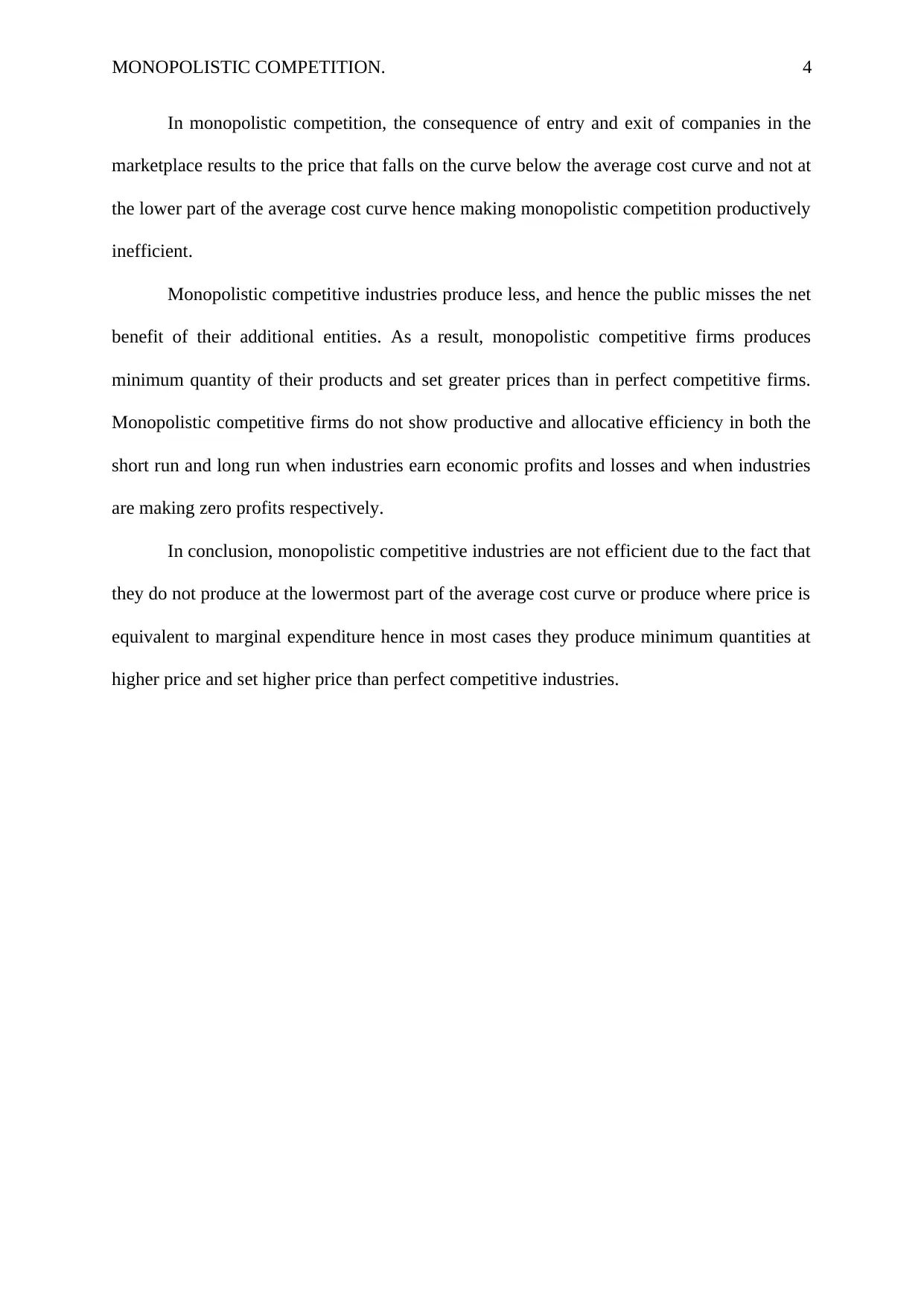
MONOPOLISTIC COMPETITION. 4
In monopolistic competition, the consequence of entry and exit of companies in the
marketplace results to the price that falls on the curve below the average cost curve and not at
the lower part of the average cost curve hence making monopolistic competition productively
inefficient.
Monopolistic competitive industries produce less, and hence the public misses the net
benefit of their additional entities. As a result, monopolistic competitive firms produces
minimum quantity of their products and set greater prices than in perfect competitive firms.
Monopolistic competitive firms do not show productive and allocative efficiency in both the
short run and long run when industries earn economic profits and losses and when industries
are making zero profits respectively.
In conclusion, monopolistic competitive industries are not efficient due to the fact that
they do not produce at the lowermost part of the average cost curve or produce where price is
equivalent to marginal expenditure hence in most cases they produce minimum quantities at
higher price and set higher price than perfect competitive industries.
In monopolistic competition, the consequence of entry and exit of companies in the
marketplace results to the price that falls on the curve below the average cost curve and not at
the lower part of the average cost curve hence making monopolistic competition productively
inefficient.
Monopolistic competitive industries produce less, and hence the public misses the net
benefit of their additional entities. As a result, monopolistic competitive firms produces
minimum quantity of their products and set greater prices than in perfect competitive firms.
Monopolistic competitive firms do not show productive and allocative efficiency in both the
short run and long run when industries earn economic profits and losses and when industries
are making zero profits respectively.
In conclusion, monopolistic competitive industries are not efficient due to the fact that
they do not produce at the lowermost part of the average cost curve or produce where price is
equivalent to marginal expenditure hence in most cases they produce minimum quantities at
higher price and set higher price than perfect competitive industries.
Paraphrase This Document
Need a fresh take? Get an instant paraphrase of this document with our AI Paraphraser
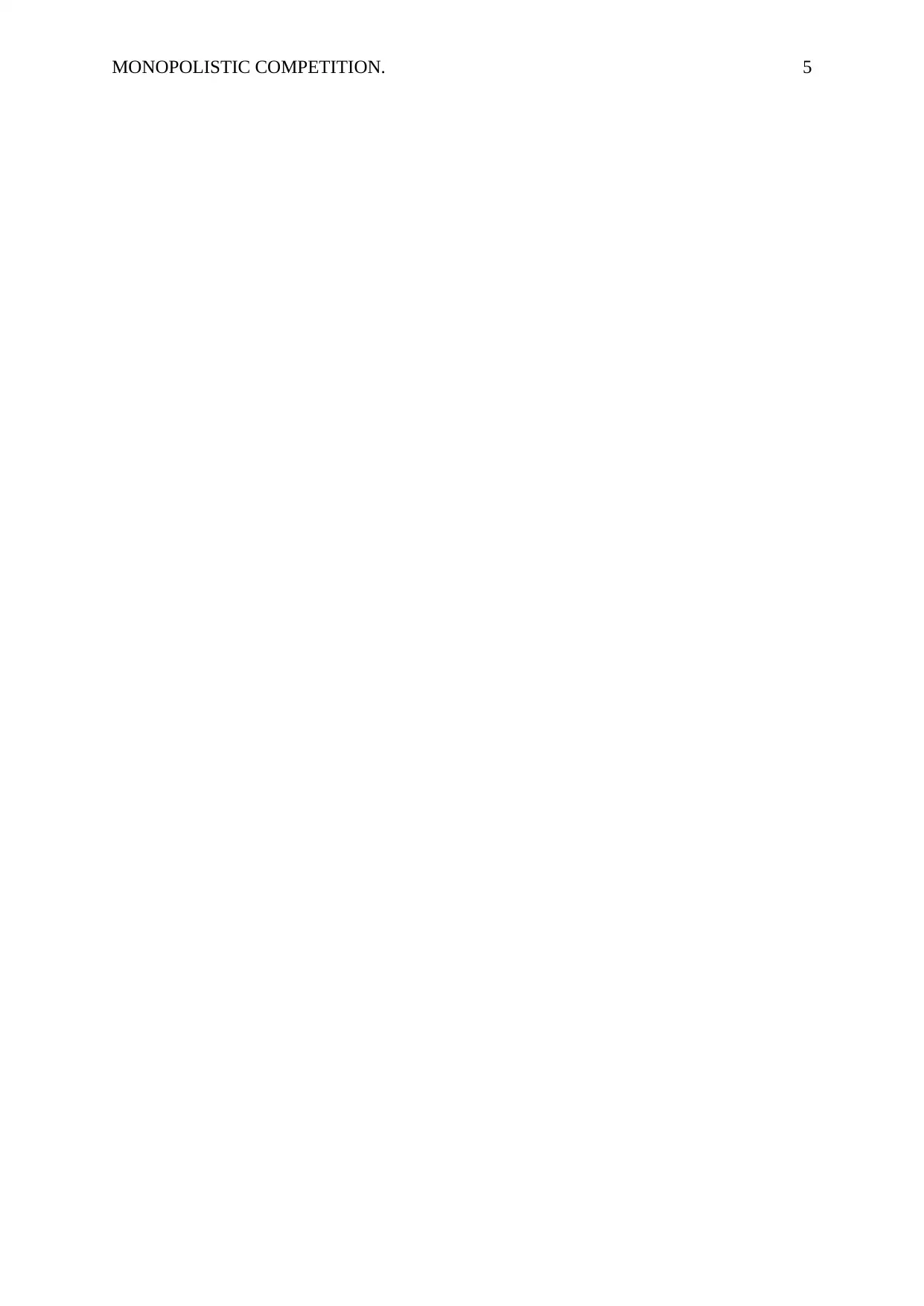
MONOPOLISTIC COMPETITION. 5
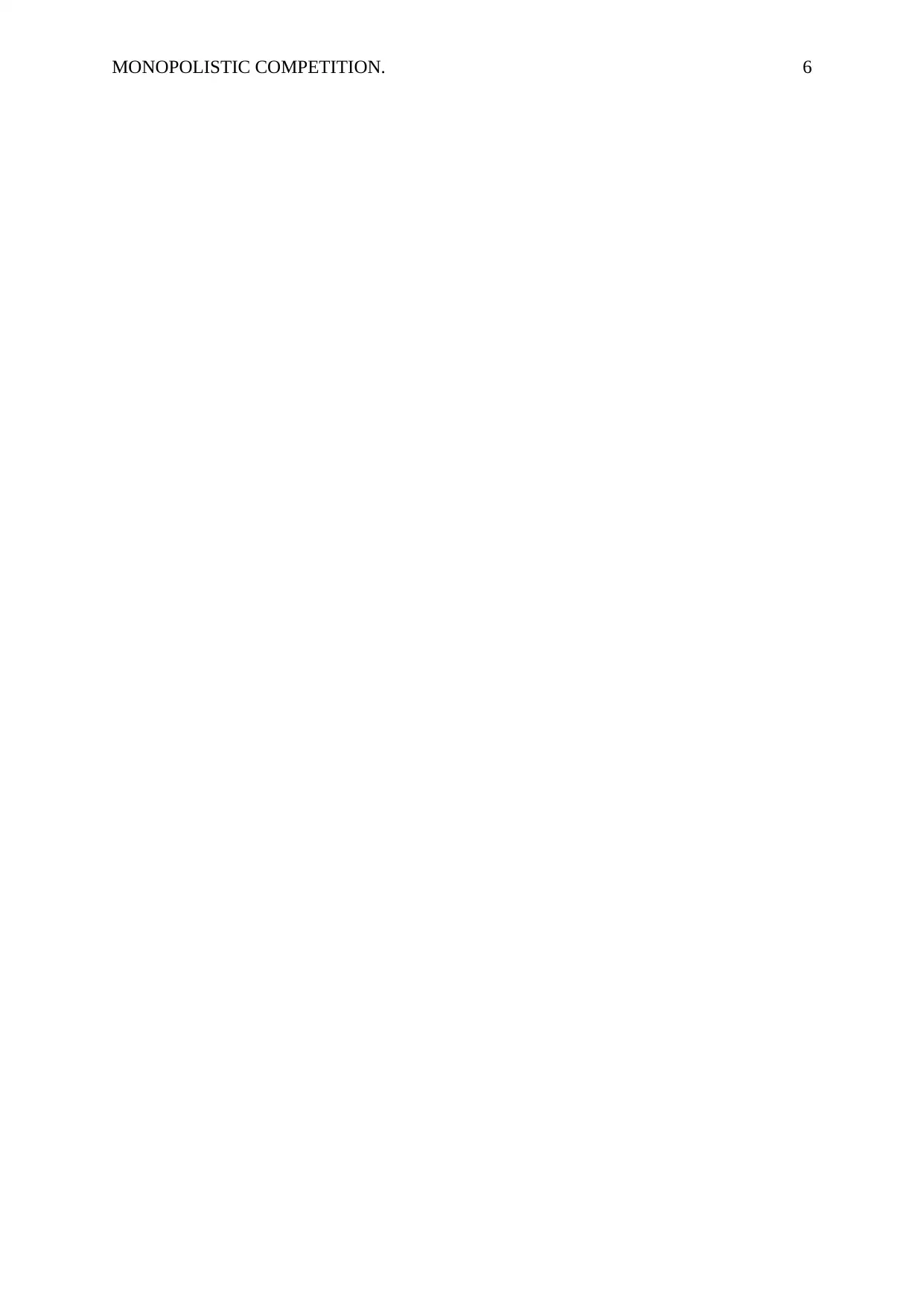
MONOPOLISTIC COMPETITION. 6
⊘ This is a preview!⊘
Do you want full access?
Subscribe today to unlock all pages.

Trusted by 1+ million students worldwide
1 out of 6
Related Documents
Your All-in-One AI-Powered Toolkit for Academic Success.
+13062052269
info@desklib.com
Available 24*7 on WhatsApp / Email
![[object Object]](/_next/static/media/star-bottom.7253800d.svg)
Unlock your academic potential
Copyright © 2020–2025 A2Z Services. All Rights Reserved. Developed and managed by ZUCOL.





